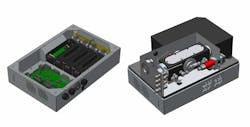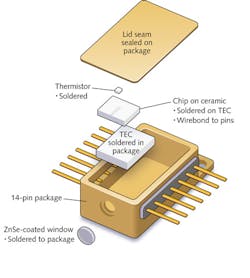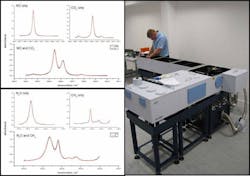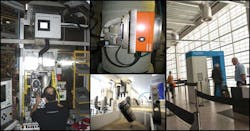QUANTUM-CASCADE LASERS: Quantum-cascade lasers disrupt gas measurement technologies
Interest in the quantum-cascade laser (QCL) has dramatically increased as end users look to solve measurement problems not possible with conventional technologies. Key drivers such as immunity to cross-interference, speed of response, increased dynamic range, and improved measurement accuracy has led clients—many of which are large blue-chip multinationals—to work in partnership with the QCL industry to develop novel QCL-based solutions.
In order to tap into these commercial opportunities, industry recognized that a ruggedized gas measurement platform was required that could quickly and cost-effectively meet the wide range of conflicting requirements for the end-user application. In response, Cascade Technologies developed a QCL-based gas-detection engine around a modular architecture that meets these needs and is both serviceable and upgradeable in the field.
An industrialized platform
Our design approach uses packaged lasers housed in individual light modules that can be kinematically and repeatably mounted/demounted to the optical train (see Fig. 1). The light from each module is collimated, with all alignments set and fixed in the factory. Each module contains the key operating characteristics of the laser and gas database, which is interrogated by the motherboard and passed to the control software. Hot replacement of the individual modules for service/repair/upgrade is easily accomplished on site, enabling continuous operation without realignment or reconfiguration of software. The electronics have in turn been built to IPC-610 standards and independently verified to operate reliably at ambient temperatures of 70°C and with high humidity and vibration.
The modular architecture extends to the optical train and enables a number of different optical configurations, such as a dual-path-length gas cell that supports both long (4–100 m) and short (0.1–4 m) path lengths simultaneously. Each path is configured to suit the application requirements for improved dynamic range. The gas cell has low volume (0.25 l) for fast gas exchange, is perfluoroalkoxy (PFA) coated to minimize gas adsorption effects, and can operate at temperatures in excess of 200°C making it suitable for many industrial process applications. Alternately the hardware can be set in an open-path configuration for ring-fence applications where the laser is projected around the perimeter of an industrial site or storage facility and used to detect leakage of hazardous materials, or for cross-stack applications in which the laser is fired directly across the diameter of an exhaust stack such as those used in power stations for continuous emissions monitoring.
The development of multiple QCLs on a single chip will only improve the capabilities of these novel sources for gas measurement applications. Here, a single, compact, and all-solid-state semiconductor light source can provide singlemode laser emission at up to 50 discrete wavelengths across a broad spectral region in the infrared. Each wavelength is individually addressable, providing an instantaneous broadband measurement capability that can be used to target many industrially relevant gases including large, heavy molecules and long-chain hydrocarbons not normally accessible to narrowband laser sources.
Reliability
The biggest question mark within the gas-measurement industry concerns the longevity and reliability of the QCL itself. Even today, many QCL devices are sold to the research sector mounted on copper bar submounts somewhat perversely designed for ease of handling. Thermal mismatch between the die and submount, the use of indium-based solder containing flux, compounded with contamination from facilitated human handling means that devices typically have a lifetime of less than 12 months. Questions regarding QCL reliability, then, should not come as a surprise.
We have worked closely with the semiconductor industry to implement Telcordia standards to manufacture, mount, and package the QCL resulting in mean-time-to-failure (MTTF) values greater than 15 years (see Fig. 2). The outcome of this collaboration is improved packaging. We moved to an aluminum nitride (AlN) submount that is thermally matched to the indium phosphide (InP) laser substrate. The use of pre-deposited gold-tin (AuSn) solder enables hard soldering at 280°C to prevent fatal indium migration that is typically associated with soft-solder techniques. An optimized solder pyramid scheme for the other packaged components, including the thermistor and Peltier cooler, ultimately allowed us to solder the zinc-selenide (ZnSe) antireflection-coated window to achieve a fully hermetic, volatile-free environment. Finally, through careful engineering of the internal package and optimum material selection suited to mid-infrared radiation, we developed a unique approach to suppress optical internal reflections from the uncoated QCL back facet to remove the risk of generating laser instability due to optical feedback.Spectroscopic developments
At the typical pressures and temperatures for industrial gas measurement, the linewidth of the QCL source is still significantly lower than the linewidth of the spectroscopic absorption features, allowing spectral signatures to be accurately modeled using the Beer-Lambert law. A critical part of this approach is an accurate spectral database for both the target and cross-interfering gases. Publicly available databases, especially at elevated temperatures, have proven inadequate. Investment in a high-resolution spectral mapping facility with a 0.004 cm-1 Fourier-transform infrared (FTIR) spectrometer with integrated high-temperature gas cells allows line strengths, line positions, and pressure and temperature dependencies to be accurately compiled (with traceability to primary gas standards). A benefit of this approach is that instrument response is directly related to a proven theoretical model minimizing the requirement for zero and span correction.
Cross-interference effects can also significantly degrade instrument accuracy and are a major limitation in conventional gas analyzers. With QCL light sources, interfering gases disrupt primary measurements in two ways: They present additional absorption lines in the spectral window that overlap or obscure the absorption feature used in the analysis of the primary gas, and/or they cause intermolecular interference whereby large quantities of gases such as water or carbon dioxide in the measurement stream cause physical deformation of the primary gas molecule through intermolecular collisions. This deformation causes perturbations in the quantum-mechanical energy levels that change the shape and intensity of the absorption features despite a fixed pressure, temperature, and gas concentration.
The spectral band measured by our patented intrapulse technique enables many absorption lines to be observed simultaneously (see Fig. 3). In general, we carefully select the laser wavelengths to minimize absorption-line coincidence; however, where this is not possible the additional lines from secondary gases are included within the spectral database and used in the algorithms that analyze the laser spectra. This technique has been successfully implemented in a number of applications including raw exhaust measurements where many interfering gases coexist. Here, a single laser can measure multiple gases simultaneously—that is, we can typically measure between 8 and 16 gases using four laser modules in an analyzer.The algorithms that analyze the laser spectra measure the area and shape of the absorption lines to determine gas concentration rather than simply using the intensity of the absorption peaks. In cases where intermolecular interference leads to collisional broadening effects we retain interference immunity by exploiting the fact that the area under the absorption will remain constant for a fixed concentration of gas despite variations in line-broadening parameters. A typical performance metric is that the cross-interference effect should be equivalent or less than the limit of detection of the analyzer and this can be achieved for QCL analyzers without any empirically derived post-measurement correction.
Industrial applications
To date, commercial traction with QCL-based analyzers has been largely focused on niche industrial applications where the unique selling points are well-matched to the measurement problem. An excellent return on investment (ROI) was also required to mitigate the risk of industry investing in a new and untested technology. Examples include the development of a high-speed leak-detection system for the aerosol industry, allowing aerosol production lines to be increased from 150 cans per minute to 500 cans per minute; a fast-response, highly accurate carbon monoxide/carbon dioxide (CO/CO2) exhaust flue analyzer for domestic boiler production lines, enabling legislated boiler setting time to be reduced from 90 to 20 s; and the formal launch of rapid-response, highly accurate QCL gas analyzers for automotive test-bed applications where the legislative demands for reduced emission levels are proving a challenge to conventional methodologies (see Fig. 4).The seeding of QCL products in these markets and the demonstration of long-term reliability and real-world performance benefits are expected to lead to a growing acceptance of this technology in several global markets. Continuous emissions monitoring is perhaps one of the largest markets, with recently accredited QCL analyzers expected to displace conventional analyzer technology. The drive toward lower emission levels combined with long procurement cycles means that traditionally conservative end users are looking to a futureproof measurement capability with low lifetime costs. Within the security sector, the ever-evolving threat of improvised explosives combined with fast throughput and low false positives/negatives has led to the trials of QCL-based screening of passengers at airports in the UK. Finally, we are now seeing the exploitation of QCLs in defense applications where a compact, semiconductor-based infrared source with excellent brightness and fast response can be used for infrared countermeasures to defeat incoming missiles to aircraft.
About the Author
Iain Howieson
Director of R&D, Cascade Technologies
Iain Howieson is director of R&D at Cascade Technologies (Glasgow, Scotland).



